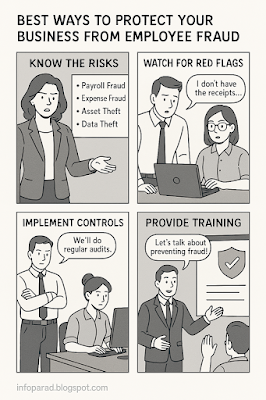Best Ways to Protect Your Business from Employee Fraud
Best Ways to Protect Your Business from Employee Fraud
📌 Table of Contents
- Why Employee Fraud Protection Matters
- Common Types of Employee Fraud
- How to Detect Employee Fraud
- Effective Prevention Strategies
- Useful Resources
Why Employee Fraud Protection Matters
Employee fraud is one of the most significant risks facing small and medium-sized businesses today.
According to the Association of Certified Fraud Examiners (ACFE), organizations lose an estimated 5% of their annual revenues to fraud each year.
This is not just a financial issue—it can damage your reputation, erode trust within your team, and expose your business to legal troubles.
Proactively addressing this risk is essential for sustainable success.
Common Types of Employee Fraud
To protect your business, it’s important to understand the different forms employee fraud can take.
Here are some of the most common types:
Payroll Fraud: Fake hours, ghost employees, or unapproved bonuses.
Expense Reimbursement Fraud: Inflated or fake receipts submitted for reimbursement.
Asset Misappropriation: Stealing inventory, equipment, or funds.
Data Theft: Unauthorized access and misuse of customer or proprietary data.
Bribery or Corruption: Accepting or offering kickbacks in exchange for business favors.
How to Detect Employee Fraud
Detecting fraud early can save your business a great deal of trouble.
Here are some red flags to watch for:
Unusual Behavior: Employees who avoid taking vacations or are overly protective of their work may be hiding something.
Missing Documentation: Lack of supporting documents for transactions can indicate fraud.
Sudden Lifestyle Changes: An unexplained upgrade in lifestyle could point to illicit income.
System Access Logs: Reviewing digital footprints can reveal unauthorized actions.
Regular audits and surprise checks are crucial in detecting fraud early.
Effective Prevention Strategies
Prevention is always better than detection.
Implementing strong internal controls and promoting a transparent work culture can significantly reduce the risk of employee fraud.
✅ Key Prevention Tactics
Segregation of Duties: Never let one employee handle an entire financial process end-to-end.
Whistleblower Programs: Create anonymous reporting channels for employees to report suspicious activities.
Background Checks: Thoroughly vet new hires before onboarding.
Regular Audits: Schedule internal and external audits to keep operations transparent.
Training: Educate your staff on company policies and fraud awareness.
Culture plays a big role—when ethical behavior is expected and reinforced, fraud is less likely to occur.
Useful Resources
To dive deeper, here are some reliable sources that offer tools, checklists, and deeper insights into fraud prevention:
You can also explore the official ACFE site at acfe.com for industry reports and tools.
Want more on compliance, internal controls, and fraud prevention case studies?
Employee fraud can be devastating—but with the right mix of awareness, processes, and tools, you can safeguard your business from within.
Keywords: employee fraud prevention, business risk management, detect internal theft, anti-fraud strategy, internal audit
